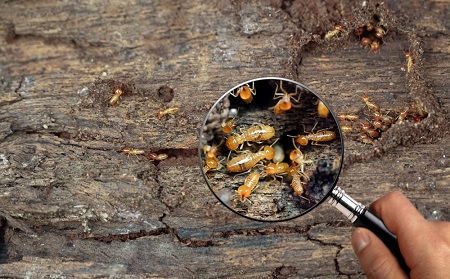What Are the Types of Termite Damage?
 Termites might seem like a minor problem until you face them yourself. There are over 40 species of termites in the United States, making termites the most prevalent problem for house owners all over the country. If the termite infestation isn't identified and eliminated early, termite damage repair can cost a fortune.
Termites might seem like a minor problem until you face them yourself. There are over 40 species of termites in the United States, making termites the most prevalent problem for house owners all over the country. If the termite infestation isn't identified and eliminated early, termite damage repair can cost a fortune.
Though there are 40 different species of termites in the U.S., only four species are the most common – subterranean termites, drywood termites, dampwood termites, and Formosan termites.
All these termites cause damage to the property, but you can spot a difference in the pattern of the damage. Professional termite exterminators will be able to track the mound of the termites by following the damage, which later leads to the identification of the termite species. Identifying the type of damage and the termites causing it can help find a suitable termite treatment method.
Types of Termite Damage
Termites eat away anything that contains cellulose which can cause great damage to properties, especially those built mostly of wood. Leaving the termite infestation unidentified can prove disastrous for your property. Here are some types of termite damage which can be the result of various stages of termite infestation.
Also Read: How Do You Know if You Have a Termite Infestation?
Structural Damage
Termites love wood but can still drill through plaster, metal siding, and more. While any type of termite damage is undesirable, one type that homeowners should avoid at any cost is structural damage.
Termites eat away anything in wood and could include important structures like support beams, columns, and foundations. This can easily compromise the structural integrity of your house, and repairing it can cost you a lot. A property with structural damage also has reduced resale value.
Subterranean termites mainly cause this damage since they live in underground colonies. Fumigation termite control is often recommended to eliminate severe termite infestations. Termite baits and liquid termite barriers around the property can offer future protection from these species of termites.
Drywall Damage
Drywalls usually consist of plaster panels covered with paper. You might notice pinprick-sized holes on the drywalls and possibly ceilings too. Termites use these holes to push out their fecal matter. Hence, consider small wood pellet-type substances near the walls a possible sign of termite activity in your home.
Drywood termites mainly cause drywall damage. These termites tend to work from within the walls; hence, they do not show obvious signs. Treat it as an early sign if you notice bubbling or peeling paint. If the infestation is left unattended, you will start to see veneer cracks and maze-like tunnels on the walls and floorboards.
Termite infestation in drywalls is a sign of moderate termite activity in your home, and it is important to call a termite control professional immediately. Drywood termites silently eat away at your home without showing any early signs. Fumigation termite control is possibly the most efficient method of termite control against severe drywood termite infestation.
Decaying Wood
If you have a warehouse or a place where you store unused wood, then you might notice the wood starting to decay. This might be a possible sign of dampwood termite infestation.
These termites usually build colonies in damp places and are attracted by wet wood. Piles of leaves, wooden logs, and tree trunks are some of the common areas where you can find dampwood termite activity. If you have a lawn or a garden, then you should clean it regularly, and it is best to get rid of unused wood. If needed, store them in dry places.
Dampwood termites can also cause plumbing issues. If your exterior windows or doors do not close properly, then it is better to get your property checked by a termite control professional.
Damage to Furniture
Even houses built from materials other than wood tend to have wooden furniture. Termites often attack furniture and can soon spread all over the property.
Knock on the furniture, and if you notice a hollow sound and also see tiny holes in your furniture, then it is time to schedule a termite inspection.
Signs of Termite Activity
There are some other signs of termite activity that you should keep an eye out for on your property. These include:
- Mud tubes
- Discarded wings
- Swarming termites
- Termite droppings
- Tiny holes in the walls and furniture
- Curling of laminate tiles
- Buckling walls
- An appearance of water damage
- Mildew or mold-like smell
- Maze-like tunnels in the wood
Also Read: Suspect Termite Activity in Your Home? Never Skip Checking These Places!
HiTech Termite Control
It would be best if you always looked for termite infestation on your property. But the process doesn't stop just with spotting them. You can eliminate termites from your property with our help. Check out the termite control services offered.
- Sep 29, 2022
